What house plants can cause trouble and why they can not be kept at home?
Content:
Indoor plants create in any house an individual atmosphere unique to this dwelling. They make the home cozy and warm, caring for home plants is a pleasure. No one will probably argue that these are living organisms that affect the human health and psyche.
But there are harmful indoor plants that can be dangerous to human and animal health. The juices of many of them irritate the mucous membranes, cause swelling, vomiting and damage the skin. This is especially true for cats who like to eat fresh herbs if they are constantly at home. Pet owners are well aware that their green windowsill can suffer from pets, but animals can also suffer if they swallow a stem or leaf of a poisonous flower. What plants are the most harmful?
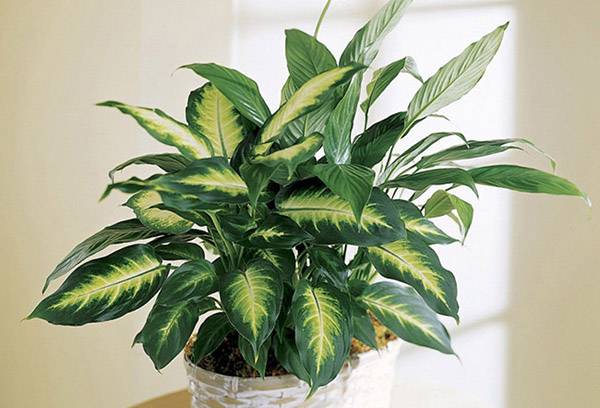
Dieffenbachia
Dangerous neighbors
As for energy, the advice to get rid of stunted and diseased plants in time is psychologically justified. Few will feel better at heart when they see a dying plant. If for some reason it was not possible to keep it healthy and strong, then the best way would be to give the plant to someone who competently puts it in order.
However, the worst threat is posed by non-diseased indoor flowers - from a safety point of view, you cannot keep plants at home whose leaves and fruits contain toxic substances. Even if gardeners take all precautions, these indoor “pets” are dangerous for young children and pets who do not have a developed sense of danger.
Danger of the Aroid family
The juice of many Aroid representatives is poisonous. It contains green parts of the plant. If swallowed, swelling of the oral cavity occurs, and if it gets into the eyes, corneal diseases and conjunctivitis.
This family includes such popular indoor flowers:
- aglaonema;
- alocasia;
- anthurium;
- dieffenbachia;
- zamioculcas (dollar tree);
- zantedesia (calla);
- monstera;
- syngonium;
- spathiphyllum (female happiness).
- Dieffenbachia - a beautiful plant with decorative leaves, in the place of a cut or fracture of the stems and leaves gives off milky juice, which can cause irritation on the skin or burns to the retina of the eyes. If a large amount of juice gets into the mouth, a severe burn of the mucous membranes appears.
Similar properties are possessed by: euphorbia poinsettia, akalifa, codium, philodendron, calla, aglaonema. Their juice irritates the skin and mucous membranes of the mouth and eyes, when it enters the intestines, it causes nausea, diarrhea and vomiting. Hyacinth, clivia, hippeastrum.
Danger for cats monstera - if they swallow part of the sheet, a burning sensation will appear in the mouth, blisters. Creeper juice contains poison that causes diarrhea. With dieffenbachia poisoning, there is a risk of suffocation. Plants harmful to human health are often valued for their beneficial properties and are kept at home as medicinal plants. For example, alocasia juice is used in folk medicine: it is believed that its tincture is effective against cancer.
Kutrovye - dangerous handsome
Poisonous milky juice is found in attractive plants of the Kutrovy family. It can greatly harm both the pet and the person.Substances contained in allamanda, catharanthus, pachypodium and rauwolfia can be fatal. One of the representatives - obese adenium, is gaining popularity among flower growers due to the unusual thickened form of the stem - caudex. These indoor plants are considered home decoration. Their flowers are very beautiful: over the past few years, breeders have bred an inconceivable number of varieties with a variety of colors, non-double and double petals.
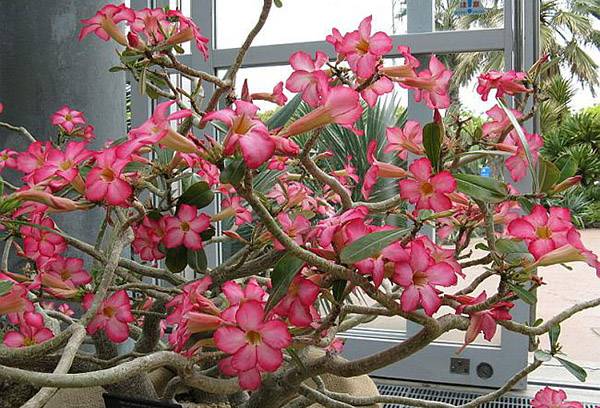
Adenium is fat
Mandeville, or diplomacy, is the dream of many amateur gardeners, which can become the highlight of any collection. But its juice contains substances that, when ingested, cause disturbances on the part of the nervous and cardiovascular systems. For small animals, such as cats, this is certain death. Oleanders are very attractive and dangerous plants that are often kept at home. They are called the “flower of suicides”: just one leaf entering the body is enough to cause irreversible consequences.
- Oleander - a decoratively flowering plant that releases during flowering an aroma capable of fainting. The juice of the stems and leaves of the oleander can cause blindness due to a burn of the mucous membrane of the eye.
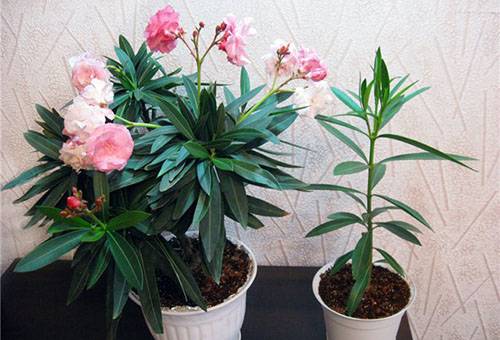
Blooming oleander
The danger of bulb plants
Almost all bulbs, in particular the Amaryllis family, are poisonous. The Amaryllis family can harm birds and other pets, especially cat lovers. This refers to eucharis, hippeastrum, clivia, gemanthus, poultry and garden representatives of the family. The green parts and scales of the bulbs contain cavities with mucus that flows if they are damaged. Clivia can cause paralysis.
The poultry catcher has a very burning juice, which, however, is also used for medicinal purposes. Some people grow it at home specifically to prepare tinctures for pain in the spine.
Solanaceous - bright and dangerous
Solanaceae, whose berries look very attractive to birds (and children), contain alkaloids that cause nausea, drowsiness, and vomiting. This is nightshade, indoor decorative peppers, brugmansia, brovallia - they are often at home with flower growers. Datura also belongs to this family. The ancient Romans used harmful nightshade berries in order to prepare poisonous substances for their enemies. Frequent guests of summer flower beds - petunia, fragrant tobacco - are no less dangerous, all parts of these flowers are poisonous.
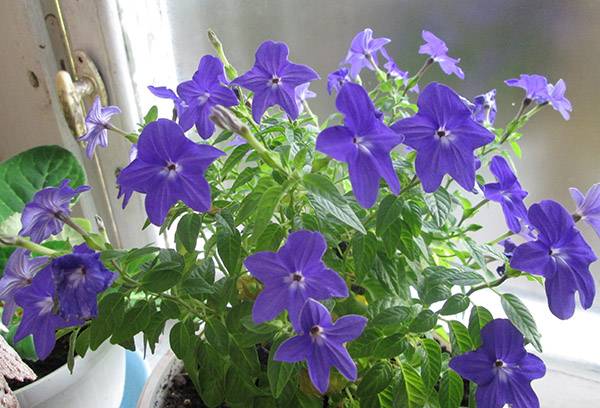
Brovallia
Potato belongs to nightshade. He ties up poisonous berries, which were previously etched by people who did not know what to eat root crops. Useful plants, often found in many people at home on the dining table: tomatoes, eggplant, peppers, also belong to this family. The fruit juices contain solanine - an alkaloid that can cause insomnia, dizziness, diarrhea and diseases of the cardiovascular and nervous system. Contact with poisonous parts of the plant may result in numbness of the muscles, impaired thyroid function, chronic joint pain, impaired absorption of calcium.
- Nightshade, brunfelsia, brovallia, clivia - their attractive fruits and berries are so poisonous that, once in the body, they cause drowsiness and dilated pupils, abdominal pain and vomiting.
- Primrose cyclamen - contraindicated for those who suffer from allergies, such people immediately begin to have allergic dermatitis, skin inflammation.
Euphorbiaceae - a harmful family
No less dangerous is the Euphorbiaceae family. Do not allow contact with children, birds and animals, especially cats. White-veined euphorbia is very similar to a palm tree in appearance - it often lives at home with amateur gardeners, as it is a shade-tolerant plant, does not require special care, and is easy to breed. Milkweed is also popular, with some varieties of which have very decorative flowers.
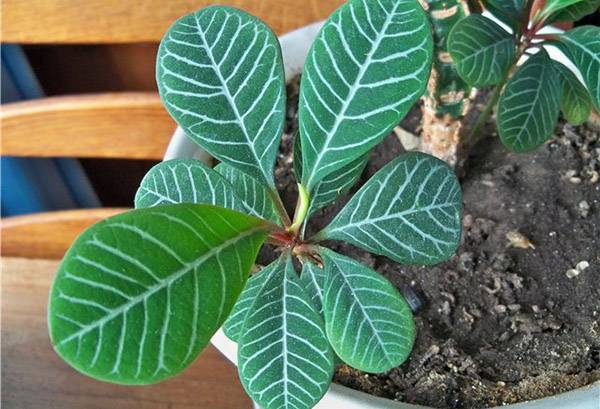
Euphorbia white-veined
Croton - an attractive plant with colorful leaves of an unusual shape - also applies to euphorbiaceae. Other members of the family, common in indoor floriculture, are jatropha, akalifa. Their resin and juices contain poisons that cause severe poisoning, which are accompanied by the appearance of vomiting and impaired nervous regulation. In contact with them, non-healing ulcers, burns and inflammations appear on the mucous membranes.
Conifers and Araliaceae
Coniferous houseplants are rare guests of the house, except in the form of bonsai. But it is worth remembering that they can be dangerous. Some representatives contain poisons that irritate the mucous membrane and gastrointestinal tract, inhibit the heart muscle and can cause respiratory arrest. For example, yew was known for similar properties in ancient times: with its help it was possible to poison enemies if they were served wine in a goblet of this tree.
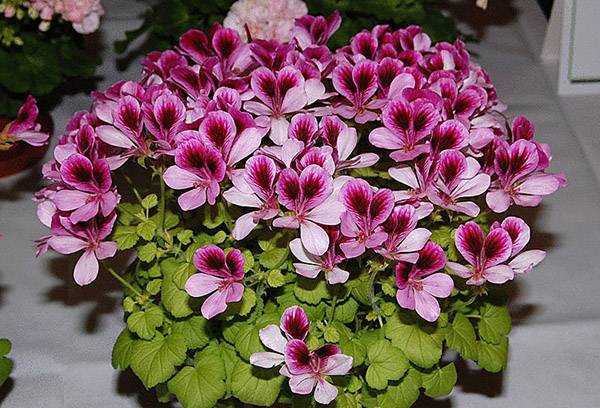
Pelargonium
The fruits and seeds of a plant of the Araliev family contain toxic substances that cause disturbances in the nervous system. His room representatives are often found at home and cause curiosity in cats:
- Aucuba Japanese
- begonia,
- pelargonium,
- poliscias,
- Fatsia
- Fatshedera
- Scheffler.
Very intensely toxic compounds are released during the care of plants (watering, spraying, reproduction).
If you still decide to grow these indoor plants in your apartment, remember the first aid measures.
- Wash skin with poisonous juice with soap and water.
- If poisonous juice enters the mouth, take absorbents (activated charcoal), induce vomiting.
- Rinse the affected mucous membrane of the eye with running water for about 20 minutes, then consult an ophthalmologist.
- In case of poisoning of children, pets or the appearance in adults of signs of a violation of nervous, cardiac activity, consult a doctor immediately.
Knowing which house plants cannot be kept at home, one can foresee many unpleasant situations related to the health of family members.
Indoor plants harmful to cats
For cats that live at home, there is a problem: how to find greens for themselves, which is a source of vitamins and a means of cleansing the intestines. Therefore, they often gnaw indoor plants, not paying attention to whether they are harmful or useful. Some owners believe that pets themselves should figure out what flowers they can eat, but this is a fallacy. These animals are very fond of hard dracaena leaves, which can scratch their palate and cause laryngeal edema. Often they gnaw ficuses containing poisonous milky juice. The most dangerous for cats are adeniums, oleanders, dieffenbachia and monstera, the ingestion of leaves of which can be fatal.
Indoor plants, if at home there is an animal or a child who does not understand what is pulling in his mouth, you need to choose especially carefully. Cacti, which for some reason often attract cats, are very dangerous for animals. The thorns are stuck in the sky, and it is very difficult to take them out without causing additional injuries to the animal
Tip
If this still happened, put a piece of butter in the pet’s mouth and take it to the veterinarian.
Even a very beautiful and, at first glance, harmless flower, such as pelargonium, can cause a strong allergic reaction. Medicinal plant aloe, which is in almost every home, can be irritating to the skin and intestines.
Tip
Harmful indoor plants are not so dangerous if they are in an inaccessible place. Therefore, if there are animals in the house, especially cats, and it is impossible to get rid of the flower, it is better to remove them away so that the animal could not get. You can hang them from the ceiling in a special planter.
Signs and superstitions
Believing or not popular beliefs about which flowers cannot be grown at home is everyone's personal business.Here a simple law works: if you believe in these superstitions - they will come true, if you are indifferent to signs - the troubles predicted by them will bypass you.
Here are a few superstitions associated with indoor plants.
- Do not keep creepers or ampelous species of houseplants at home - men in the family will not linger. In this regard, such “husbands” are dangerous, such as: scindapsus, tradescantius, zebrin, ivy, rafidofora, reo, roicissus, campelia.
- Palm trees donated by someone, but not grown personally, will bring great grief to the house.
- Cacti attract drunkenness to the family. On their account there is another sign - a girl living in a house where cacti grow, is doomed to remain an old maid.
- Monstera, ferns, philodendrons - energy vampires, they deprive the inhabitants of the forces, sucking life out of them. Why did the beautiful monstera fall into such disfavor? Maybe because of the name, or maybe because of its aerial roots, similar to tentacles.
- Geranium is a plant of lonely people. This superstition, apparently, arose because of the love for this flower of retired grandmothers, that is, the reason was confused with the consequence.
Despite these superstitions, there are a huge number of examples when families who grow cacti, vines, and geraniums live very happily.
Indoor floriculture in Feng Shui
The popular oriental doctrine of Feng Shui can offer some advice on which flowers should not be placed in an apartment or other person’s home.
- You can’t keep at home indoor "pets" that cause antipathy among the owners, otherwise they will radiate negative energy around.
- The same statement applies to sick and drying plants.
- Cacti or similar succulents with thorns and hard leaves can not be placed in places of rest, in the bedroom.
- Any floral arrangement using bonsai symbolizes a developmental restriction, so it is undesirable for Feng Shui to have such translators of negative information in a person’s home.
- In addition to cacti, yucca, sansevier, or "pike tail", echmea, neoregelia, orchid have heavy energy. Being with them a large amount of time in one space, you can get not only a headache, but also problems in the family and at work.
Look into the bedroom
In no room in a house or apartment does a person need positive energy and clean air as much as in a bedroom. Not only a full rest from day cares, but also health and intimate relationships depend on what house plants he is going to keep and grow there.
It is undesirable to put plants with a large mass of leaves in the bedroom: monstera, ficus, fern. In the dark, they will intensively absorb oxygen, which is already needed by the inhabitants of the house. Flowers with strong aromas (lilies, gardenia, orchids, hydrangea), as well as those that emit toxic fumes: oleander, alocasia and many others listed above. Even geraniums can cause a headache if kept in the bedroom on the windowsill of the south side.
If family members suffer from asthma or allergies, it is better to completely abandon the plants in the bedroom. Constantly moist soil in flower pots, spores of some plants, molds, possibly present in a humid environment, do not affect the well-being of such patients in the best way.
As for the recommendations of Feng Shui, according to its canons in the bedroom it is undesirable to keep:
- tall plants with spreading leaves;
- hard and prickly cacti and succulents;
- drying and sick specimens.
What flowers do Feng Shui teach advise to keep in the bedroom? These are soft and delicate specimens with thin leaves, citrus fruits, miniature varieties of ficuses, violets, scarlet.
The requirements for the colors in the children's bedroom are the same, only reinforced with security measures. You can not put there:
- poisonous varieties of indoor flowers;
- strong odor specimens;
- cacti, euphorbia and succulents;
- creepers and ampelous plants;
- flowers intensely emitting carbon dioxide, with large leaves;
- allergens.
When purchasing or growing indoor flowers, you need to pay attention to their properties: safety, the absence of allergic danger in the form of fungi, mold, spores. It is strictly forbidden to keep poisonous specimens in a house where there are children. Green decorations are especially carefully selected for placement in the bedroom, in the children's room. If folk signs and superstitions seem worthy of attention, then it is worth choosing flowers, focusing on them. No matter where the flowers are placed to decorate the rooms - in the kitchen, living room or bedroom - there is always a large selection of plants that do not pose a threat to health and energy balance.
We advise you to read an article about how to care for zamioculcus
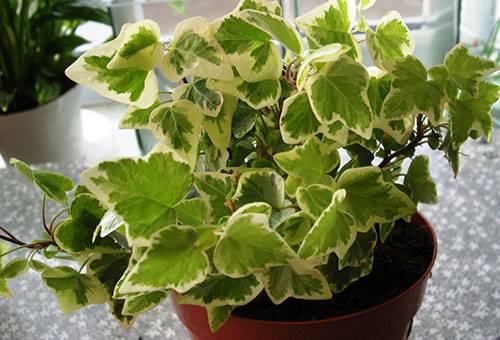


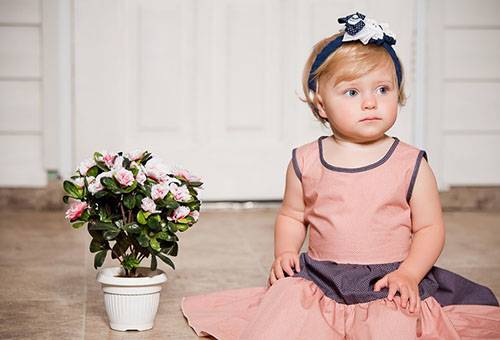
"We are responsible for those who tamed !!!"
flower antlers can be kept in the bedroom ??